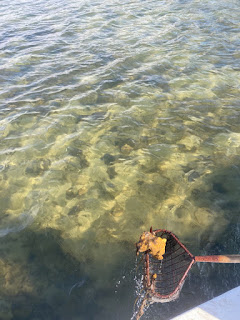Mystery sponge
 |
| Collection of the sponge in Mashpee, MA |
Identifying species is always easier if you have a physical specimen, so that was my first question for the officer: "Do you have a sample?" Two days later, a sponge appeared in my lab refrigerator.
My first step was a dissection. Sponges have skeletal elements called spicules. They're small pieces of silica or calcium carbonate that help the sponge hold its shape, and they're absolutely essential for any taxonomic identification. From the outside, all sponges look like some type of blob, so we have to peer inside to find how they differ.
I used my standard method of extracting sponge spicules - I took a small piece of tissue, put it in a tube with some bleach, shook it up, and then dumped it out in my petri dish. This method dissolves the cells, leaving only the spicules behind. As I leaned over my microscope to view the spicules, I noticed something unexpected: rocks. Dozens of them, all very small and rounded on the edges. I sat back for a second. Maybe I had just grabbed some debris from the sponge surface instead of getting an actual tissue sample. I tried again - more rocks. Sure, there were spicules in my dish too, but they were mixed in among the rocks. Could the rocks really be coming from inside the sponge?
I sliced open the sponge with a scalpel and examined the cross-section under my microscope. Yep, the rocks were embedded in the sponge tissue. I've never seen anything like that before.
After isolating the spicules and examining them under my microscope, I actually came to a reasonable identification. The sponge matched perfectly to the genus Hymeniacidon. The last step in any taxonomic identification is to verify that the species you landed on actually looks like your specimen and lives in the part of the world where it was found. I searched Hymeniacidon online and was excited to see photos resembling my specimen pop up. One site even said there was a species living in New England. Perfect!
My eyes fell on another link, this one leading to a recently-published paper. The summary said the paper presents genetic evidence suggesting that two species of Hymeniacidon are the same, and they constitute a globally-distributed exotic species that was introduced to new areas accidentally by humans. Could my specimen be this exotic species?
Answering that question required genetics. Again, I used my standard methods - I extracted the DNA, used a cleaning kit to refine it, amplified one region using PCR, and sent the product off for sequencing. I then compared the sequence from my specimen to published sequences in GenBank. As far as I can tell, the closest match for my specimen is Hymeniacidon perlevis - the exotic species.
I notified the Mashpee office of my findings and laid out how I had come to my conclusion. To be honest, I'm still pretty confused about the rocks, but maybe the sponges are just using external inorganic material to make themselves more stable. The specimens were heavy and dense, so I could imagine they're pretty resistant to things like wave action and predators. The rock thing will require more investigation to understand. In the meantime, it felt pretty awesome to be able to help my local community with science. The information I provided could be used to shape plans for invasive species removal going forward, so I'm glad I could help identify the mystery sponge!
Comments
Post a Comment